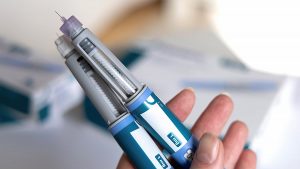Eddie Sullivan, 17, woke up on a Tuesday and found that his chest hurt every time he took a breath.
He’d spent that July weekend nauseous with a fever, and the day before doctors had diagnosed him with pneumonia, remembers his mom, Geri Sullivan.
“As the day went on, his chest pain became more severe and his breathing became more labored,” said Sullivan, 54, of Delaware County, Pa. “He commented more than once that it felt like he was only able to get enough air out of one lung.”
They couldn’t know it at the time, but Eddie was one of 530 people across 38 states who’ve experienced severe lung injuries related to vaping.
Eddie is on the mend now, but at one point doctors considered putting him on a ventilator — a prospect that terrified his mom, who lost his father when the boy was just 1 year old.
“I really felt like my world was going to crash down again, when I heard those words that he might be put on a ventilator,” Sullivan recalled.
Federal health officials are still piecing together exactly what happens in these cases of vaping-related lung injury, but experts said Eddie’s case follows a pattern that appears to be emerging.
First signs
Many patients first experience gastrointestinal symptoms like nausea, vomiting and diarrhea prior to their respiratory symptoms, explained Dr. Karen Wilson, division chief of general pediatrics at the Icahn School of Medicine at Mount Sinai, in New York City.
“It seems to be a slower onset in many of the cases,” Wilson said. “Certainly the cases I’ve heard about in the most detail have had some time before they were actually diagnosed where they were having vomiting and diarrhea.”
Eddie woke up that Saturday with a fever of around 101 degrees, and spent the weekend in bed. By Sunday night, he had severe stomach pains and repeatedly vomited.
His mom took Eddie to the hospital on Monday, where they performed a full exam and a chest X-ray before diagnosing him with pneumonia. They sent him home, but recommended that he be taken to a pediatric hospital if his condition worsened.
The next day it became harder and harder for Eddie, a strapping football player, to draw a breath.
“He was weak walking from one room to another room,” his mother said. “He needed support getting up from a recliner to stand.”
Lung symptoms related to this syndrome tend to be a dry cough, shortness of breath and chest pain, said Dr. Albert Rizzo, chief medical officer of the American Lung Association. That’s precisely what happened to Eddie.
Time in the ICU
Sullivan rushed her son to Nemours/Alfred I. duPont Hospital for Children in nearby Wilmington, Del., where doctors never even gave Eddie a chance to sit in the waiting room.
“They saw he was sweating profusely, and he was definitely having trouble breathing,” Sullivan said. Alarm spread when they clipped the blood oxygen detector to his finger.
“I could see the look of panic on the faces of the nurses when they saw his blood oxygen number,” Sullivan said. “He was whisked away from me and sent into a trauma room. He had a team of eight people around him.”
Eddie wound up being treated in the hospital’s intensive care unit (ICU), which is not unusual for these lung injuries, Rizzo said.
A recent U.S. Centers for Disease Control and Prevention report noted that about one-third of the patients in Wisconsin and Illinois required ICU treatment, Rizzo said.
Early in Eddie’s treatment, “they asked me to step out of the room so they could talk with him about teenage stuff, and it was during that time he told them that he had in the past year many times used a Juul and vaped,” Sullivan recalled.
Turns out Eddie had been vaping quite a bit without his mother’s knowledge, using either a Juul or other devices owned by his friends.
Eddie told physicians he’d vaped both nicotine and THC products, said Dr. Nicholas Slamon, a critical care specialist at Nemours/Alfred I. duPont Hospital for Children who treated Eddie.
“He had admitted to doing both,” Slamon said. “That seems to be a theme for some of the folks that have been sicker.”
Exact causes still unclear
“He claimed he stopped this about a month or two prior to when he got sick,” Sullivan said. “He had definitely been doing it for at least a year, maybe a little longer, and he was doing it frequently. It was a daily after-school thing with his friends.”
Federal health officials have not tied these cases to any specific device, compound or ingredient, CDC officials said this week.
Sullivan is terrified about what her son might have been putting into his lungs.
“He was buying most of his products in a local gas station that served him and never asked for identification,” Sullivan said. “There are so many imposter pods and liquids out there. He could have assumed he was buying Juul products, but it could have been some bootleg version of them. God knows what kind of chemicals were in it.”
The U.S. Food and Drug Administration has warned people against vaping at all, but particularly against purchasing “home-brewed” vaping liquids or devices.
“If you’re thinking of purchasing one of these products off the street, out of the back of a car, out of a trunk, in an alley, or if you’re going to go home and make modifications to the product yourself using something you purchased from a third party or got from a friend — think twice,” Mitch Zeller, director of the FDA’s Center for Tobacco Products, said in a press briefing earlier this month.
After a few days in the ICU, Eddie still hadn’t gotten any better.
“By Friday morning they clearly had seen very little progress and there was definitely talk of him being intubated and put on a ventilator,” Sullivan said.
Steroids best treatment so far
As a last-ditch effort, doctors put Eddie on an IV steroid, and “that’s when he finally started to make a recovery,” Sullivan said.
“The universal therapy, the only thing that seems to help at all, is steroids,” Slamon said of vaping-related lung injury cases.
Rizzo noted that “the thinking is this might be some kind of inflammation triggered by an exposure or an allergic reaction. They [steroids] may be able to slow down or reverse the process that’s going on in the lungs.”
The most common marker of these vaping-related lung injures is that there is no infection — just severe inflammation in the lungs, Rizzo added.
Eddie wound up spending 11 days in the ICU before he was released. He’s still recuperating.
“He does have some moments where he gets winded,” Sullivan said. “I was told by the pulmonology department his lungs will probably not be fully healed until the end of October.”
Eddie’s high school gave him an elevator key so he could get to his homeroom and classes on the upper floors, because he still gets winded going up stairs, Sullivan said.
A warning to others
Sadly, Eddie was not cleared for play on his football team. He’s still on the team, helping out by videotaping the games, but he wasn’t able to return to the offensive line, his mother said.
Doctors warned Eddie that he should never vape again, in case he damages his lungs further, and the boy has taken it to heart, Sullivan said.
“He reached out to his friends and said, ‘I’m sick because of my Juul, and you guys better knock it off, too,'” Sullivan said.
Slamon said he’s hopeful for a full recovery for Eddie.
“I expect since he’s an otherwise healthy guy that he’s going to completely recover and it will go away over time,” Slamon said. “But there’s a risk that he’s going to reach a plateau and that’s as good as his lungs are ever going to be.”
Only time will tell whether Eddie and other patients stricken by this lung injury will fully recover, Rizzo said.
About half of the cases involve people younger than 25, according to the CDC.
“Those lungs are still developing, and could have been developing more, but this damage could prevent them from reaching their full potential,” Rizzo said of the younger patients.
“It can take weeks or months for an insult like this to the lungs to completely resolve, and that resolution may sometimes be less than baseline,” Rizzo said. “My hope would be with more time, the patients are going to get back to normal.”
Wilson said she hopes that patients hospitalized for these lung injuries will also receive smoking cessation treatment, either in the form of a nicotine patch or gum, “so when they go home they can quit these products entirely.”
She added, “The people who are taking care of them should remember to treat that nicotine addiction as well.”
More information
The American Lung Association has more about vaping and lung health.
Copyright © 2025 HealthDay. All rights reserved.

























